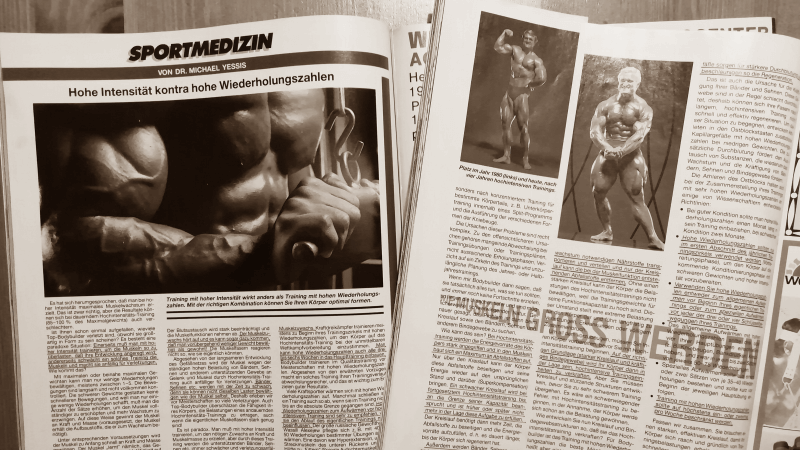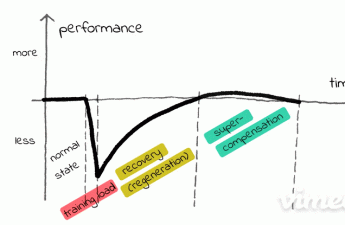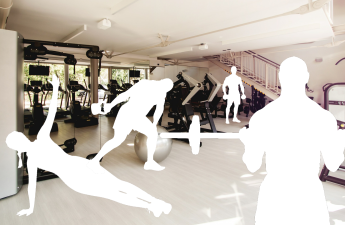Are there any recommendations as to the number of repetitions within the sets of an exercise with which one should train in order to promote regeneration? What are the effects of a few high-intensity repetitions and what on the other hand are the effects of many low-intensity repetitions? The answer is already given here: The point is to combine both in a meaningful way.
Introductory remarks
Since I already belong to the older generations – the mention of my year of birth 1965 could tempt some younger readers to stop immediately – I am rather responsible for historical considerations in the category of knowledge topics. This inevitably brings with it other source information than in the contributions of my daughter Julia, who is currently working on her diploma thesis on the fitness trainer course.
Despite the age of some sources, however, these are often relatively timeless insights that can be of very concrete value even decades after their publication. Example: Dr. Michael Yessis’ reflections on the number of repetitions in 1984, the year of my final secondary-school examination.
High intensity versus high repetition rates
A professional article with this headline appeared in the German Sport Revue from June 1984. For those who can’t remember this time (or weren’t even born then): The Sport Revue was edited by Albert Busek and was a translated version of the American Muscle & Fitness, and texts and pictures were often congruent. The mentioned author, Dr. Michael Yessis, published his article in the American M&F, of course, but unfortunately only the German version is available to me. Please be aware that the following quotations have been translated by me and are therefore probably not identical to the original American edition.
Avoidance of injuries
Yessis puts an important dilemma in a nutshell that many strength athletes have to struggle with:
On the one hand you have to train with high intensity to overload the muscles in such a way that their development is stimulated; on the other hand such training weakens the muscles and makes them susceptible to injuries.
Article by Dr. Michael Yessis: High intensity versus high repetition rates, in German Sport Revue 6/1984, p. 58
Which means: too much isn’t good. But not too little either. Apparently it’s about finding a balance. But let’s take a closer look at the problem.
Capillarization – what’s this?
Capillarization is about supplying the body cells with blood. This supply takes place via capillaries, the finest blood vessels that pass through the tissue like the cavities in a sponge.
An increase in muscle mass requires increased capillarization in order to keep new tissue and new muscle fibers healthy and to supply them with sufficient energy during training.
Dr. Michael Yessis, source as above
That sounds logical, doesn’t it? And we also assume that our body has enough capillaries, don’t we?
Blood exchange for supply and disposal
The musculature is similar to that of a household: some substances constantly have to be brought in (supplies, such as food) and others have to be taken away (disposal, such as waste). But now, in the course of the training, there is an unexpected problem for many people:
Research shows that circulation does not increase as much as muscle mass. In other words, the vascular network that keeps the muscle healthy and efficient develops more slowly than the muscle itself.
Dr. Michael Yessis, source as above
The body does not consist of muscles alone
Unfortunately, what Yessis says above doesn’t sound good at all: A slowed muscle growth is probably the last thing you want, right? But it gets even worse:
Apart from the slower development of the vascular network, the muscle also becomes more susceptible to injury due to the constant high load on ligaments, tendons and other supporting tissues in the joint and muscle due to high intensity training. Ligaments, tendons, etc. become too weak over time because they cannot handle the same loads as the muscle itself.
Dr. Michael Yessis, source as above
And that’s where the fun stops. Have you ever thought about how long an enforced break in training can last if a tendon is ripped? Or how annoying it can be – and not only during training – when a joint is constantly aching? Stupid: You just wanted to get to your training goal as quickly as possible, but after an injury it suddenly goes: Please wait.
Eliminate supply problems within the muscles
So the question arises: How is it best to get out of the dilemma described? Yessis explains:
It’s paradoxical. One has to train with high intensity to achieve the necessary increase in strength and muscle mass, but through this training the supporting ligaments, tendons etc. become weaker and more vulnerable to injury. What to do in this situation? You have to include high repetition rates with low resistance in your training program.
Dr. Michael Yessis, source as above
In this article Yessis mentions 40 to 50 at “high repetition rates”. In a later article, which we will consider at the next opportunity, he speaks about 50 to 75 repetitions.
High repetition rates: How to integrate into training?
There remains the question of how this could work in practice. Training with a high number of repetitions as part of the periodization in the course of the year? Every few weeks as an intermediate stage? Or running in the normal program? Finally, Yessis comes back to speak:
Powerlifters usually train at the beginning of their training circle with high repetition rates in order to prepare the body for the high intensity training in the immediate competition preparation. High repetition rates can also be built into the main workout every three to six weeks. […] High repetition rates for warming up before high-intensity training are highly recommended because they do not influence the sequence of the actual training.
Dr. Michael Yessis, source as above
So: Actually everything anyway – as long as you do it. High repetition rates as a warm-up program, as variety and protection from boredom, or as a specific warm-up or as a turbo for the pump effect after the last working set: Yessis seems to think that all of this is okay.
Self-sabotage?
Oh yes – one more thing: smoking narrows the capillaries quite quickly. What this means is probably immediately clear to you after reading this article: On the one hand we want a better blood circulation of our trained muscles, and on the other hand we throttle the blood supply with a cigarette. Can you make it even harder for yourself?
Repetition numbers and the role of mitochondria?
So far, so good. But what about the mitochondria in the muscle cells? So with those components within the muscle cells that play a very central role in aerobic energy supply (with the supply of oxygen)? What significance do they have when it comes to training with high repetition rates? And don’t they – like the capillaries – become more important if you train with high repetition rates?
After a certain duration of the exercise (i.e. the length of one set), the anaerobic energy production is more and more replaced by the aerobic form, whereby the mitochondria come into play. What this looks like in detail, however, would go beyond the scope here – but let’s see: Maybe this is a future topic for Julia.



